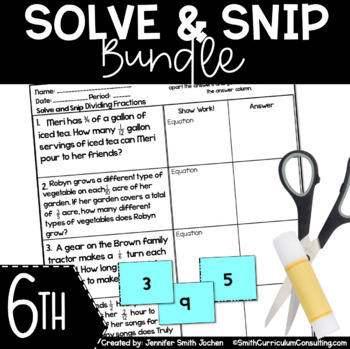6th Grade Solve and Snip® Bundle - Interactive Math Word Problems
- Zip
- Google Apps™

Products in this Bundle (46)
showing 1-5 of 46 products
Bonus
Also included in
- Solve and Snips and Solve and Slides are Interactive Practice Problems for skills aligned with TEKS, Common Core, and Oklahoma Academic Standards that each includes 10 Word Problems and self-checking answer choices to use in your classroom.In each Solve and Snip and Solve and Slide, students will rePrice $69.25Original Price $138.50Save $69.25
Description
Solve and Snips are Interactive Practice Problems for skills aligned with TEKS and Common Core that each include 10 Word Problems and self-checking answer choices to use in your classroom.
In each Solve and Snip students will read a word problem and use the second column to show their work to solve the problem. Once they have solved their problem, they will find the correct answer in the solutions bank and glue it in the answer column for the correct problem.
Included in this bundle are:
- Every ENGLISH Solve and Snip created for Sixth Grade
- 1 page of Solutions (4 per page) per Solve and Snip
- Answer Key for each Solve and Snip
- Solve and Slides for Google Drive (as they are added)
- Answer Key for Solve and Slides
Current 6th Grade Solve and Snips Include:
- Adding and Subtracting Fractions and Mixed Numbers
- Angles
- Area
- Area of Composite Figures
- Boston Tea Party Percents
- Christmas Themed Fractions, Decimals, and Order of Operations (Print and Digital)
- Christmas Themed Multiplying Decimals (Print and Digital)
- Comparing and Ordering Rational Numbers
- Converting Fractions, Decimals, and Percents
- Determining Discounts
- Dividing Fractions
- Equations with Fractions
- Equivalent Rational Numbers
- Estimating and Rounding
- Fall Themed Multiplying Decimals
- Football Fun Facts
- Fraction Operations
- Halloween Themed Mixed Operations with Decimals
- Integer Operations
- Leaving a Tip
- Mean, Median, and Mode
- Measures of Central Tendency
- New Year Themed (Multi-Digit Numbers and Decimals)
- One-Step Equations
- Order of Operations
- Patterns and Tables
- Paying Taxes
- Percent Increase and Decrease (2 versions)
- Percents
- Proportions
- Ratios
- Solving One-Step Positive Inequalities
- Spring Themed Probability
- St. Patricks Day Themed Multiplying and Dividing Fractions and Decimals
- St. Patricks Day Themed Proportions
- Taxes, Discounts, and Tips
- Thanksgiving Themed Review of Skills
- Triangles and Quadrilaterals
- Unit Rates
- Valentines Day Themed Percent Proportions
- Whole Number Multiplication and Division
- Winter Themed Review of Skills (Print and Digital)
- Winter Themed Review of Skills 2 (Print and Digital)
- Writing Equations
Solve and Snips are aligned to Common Core State Standards (CCSS), Texas Essential Knowledge and Skills (TEKS), and Oklahoma Academic Standards (OAS) for your benefit.
This bundle allows for the ability to use any/all of my Solve and Snips in your Personal Classroom throughout the culmination of your teaching career. If other teachers would like to use the Solve and Snips, please direct them to my Teachers Pay Teachers store to purchase the appropriate licensing.
**************************************************
Personal Copyright: The purchase of this product allows you to use these activities in your personal classroom for your students. You may continue to use them each year but you may not share the activities with other teachers unless additional licenses are purchased. The license for this purchase is NON-TRANSFERABLE. Site and District Licenses are also available.
Copyright © Smith Curriculum and Consulting, Inc. All rights reserved.
DISCLAIMER: With the purchase of this file you understand that this file is not editable in any way. You will not be able to manipulate the lessons and/or activities inside to change numbers and/or words.






